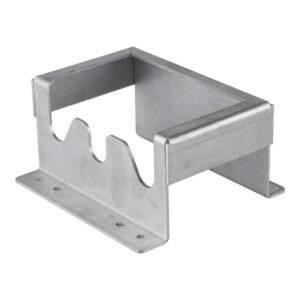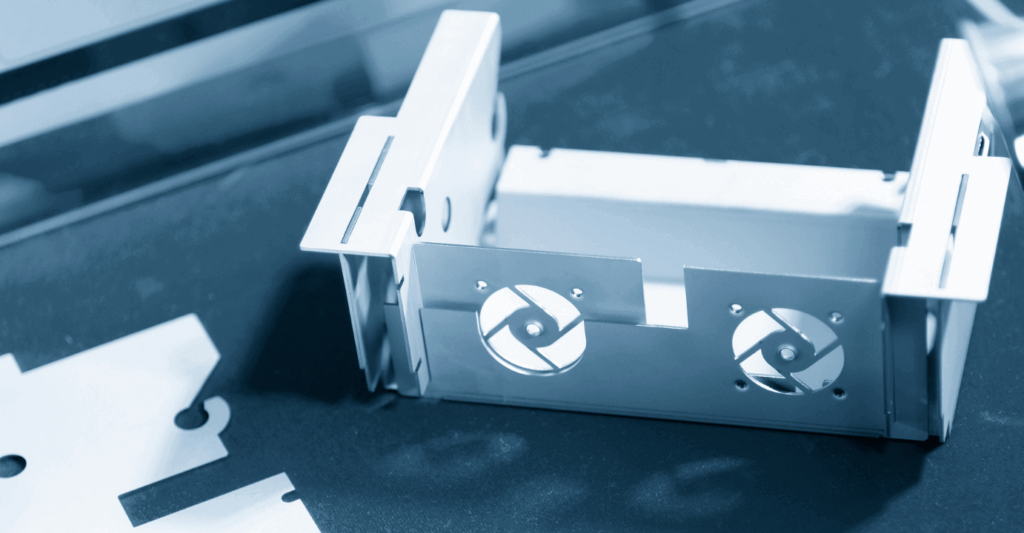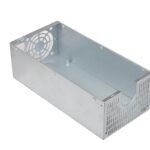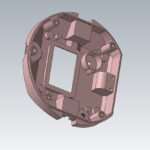Introduction
Sheet metal is arguably the most versatile material available as it handsomely meets the increasing demand for customized products. One can transform it into different forms using sheet metal bending processes that are simple and inexpensive. However, bending sheet metal requires a fair amount of knowledge since it involves several critical processes. That’s one reason why we chose to guide you through the process of sheet metal bending. This post will discuss the basics of sheet metal bending, learn about the various sheet metal bending methods, and share tips that will go a long way!
What is sheet metal bending?
Sheet metal is a material that can acquire the desired shape or form when external forces are applied to it. Applying such external forces to change the shape or form of sheet metal is called sheet metal bending. This helps make any manufacturing process efficient and productive. However, the external forces alter the sheet’s exterior features, keeping parameters like length and thickness the same.
But, how does sheet metal bend? It is the malleability of the sheet metal that helps manufacturers run the sheet through different shaping processes. For example, automotive companies work on sheet metal to create automobile parts that can work perfectly as per design. Sheet metal bending also ensures precision which helps manufacture big and small engine parts.
What are the methods for sheet metal bending?
Now that we understand sheet metal quite well, let’s go ahead and discuss the different sheet metal bending methods used in the manufacturing industries. Here are some essential sheet metal bending methods you must know.
-
V-bending
Used for most bending projects, V-bending uses a punch and v-die to bend metal sheets at desired angles. In this, the bending punch presses the sheet over the v-die at a required angle. The angle at which the sheet is bent is dependent on the pressure applied by the punch.
-
Air bending
Although known for its inaccuracy, the air bending method is still used as it is simple to implement. There are hardly any manipulations required in the process. You might not even need any tools to bend metal sheets through air bending. The only disadvantage of air bending is that it causes springback of the sheet metal. Stay with us to read more on bending springback.
-
Bottoming
In Bottoming, you have a preset die with a defined angle and shape. The manufacturer compresses the sheet metal to the preset die’s bottom. The process doesn’t introduce springback since the punch pushes the sheet metal towards the die with force large enough to give it a permanent structure.
-
Slotting
Bending can become easy if you cut slots at the bending line. Cutting slots weakens the material, and the amount of force required to bend the sheet metal reduces significantly. Slotting is perfect to design custom metal enclosures and frames for projects of all sizes. But, we would not recommend slotting for designing heavy load-bearing parts since this sheet metal bending method weakens the material.
-
Roll bending
Do you want to roll or curve your sheet metal? Use roll bending. This sheet metal bending method uses a hydraulic press, press brake, and sets of rollers to bend the sheet metal in the desired curved shape. The distance between the rollers determines the curve of sheet metal. Roll bending is advisable to form cones, tubes, or hollow shapes.
-
U-bending
We have already discussed how V-bending works. Well, U-bending is akin to V-bending. The only difference between the two is the shape of the die. Unlike V-bending, here we use a U-shaped die. In other words, the sheet metal is bent in a U-shape form. U-bending is also a prevalent sheet metal bending method.
-
Wipe bending
Wipe bending is another sheet metal bending method worth discussing. This is a method where the process entirely depends on the application of wipe die. In this, the sheet metal is pushed firmly onto the wipe die, which is also responsible for determining the sheet’s inner radius.
-
Rotary vending
Finally, we have rotary bending. This sheet metal bending method has a significant advantage over other bending methods like wipe bending or V-bending. The advantage is its ability to leave the sheet metal scratchless. You can even turn the sheet metal into sharp corners!

What is bending springback?
The sheet metal springs back when the load during the bending process is lifted. This ‘spring back’ has to be compensated for during the sheet metal bending process. In other words, the sheet metal is bent beyond the required angle – ensuring the sheet takes the required shape even after spring back occurs.
But, why does spring back occur? Well, two different physical processes occur when sheet metal is bent. To be precise, the material on the outer layer is pulled while the inside layer undergoes compression. Since compressive strength is larger than the tensile strength, it is difficult to achieve permanent deformation on the inside layer. Hence the sheet metal tends to regain its original shape.
However, one can reduce the spring back by applying a sharp punch. This ensures a small inner radius – significantly decreasing the bending

Best tips for sheet metal bending
By now, we believe that you have acquired a basic understanding of sheet metal bending and associated processes. However, we suggest you apply a few expert tips that will help you develop better products through sheet metal bending. Check out these sheet metal bending tips before we conclude this post.
-
Always check the minimum flange length
Check for the minimum flange length because you don’t want the flange to fall into the crevices. Choose a die with a width that matches the thickness of the sheet. For example, a sheet with 2mm thickness will have an inner bend radius of 2mm. You must ensure a minimum flange length of 8.5mm to create a functional design. Refer to this bending force chart to check the minimum flange length.
-
Check for bend allowance
We have already discussed the bending allowance. One should strive to yield precise results when bending sheet metal. Therefore, you must account for the bend allowance. Calculate the bending allowance using the formula mentioned above. It will help achieve accuracy in finished products.
-
Make the chamfer leave enough room
Are you looking to make a flange with chamfered ends? You must ensure that the chamfer stops before the base of the detail. Apply the minimum flange length rule but make sure the chamfers leave enough room for the bends.
-
Don’t make holes close to the bend
Pay attention when making holes close to the bend. Close-by holes may get warped, and you might face difficulty fitting the bolts through them. We recommend making holes at a distance where the bending process doesn’t make an impact. The best way is to refer to the minimum flange length from the bending force chart. Punch the holes farther than the minimum flange length.
-
Need symmetry? Make it obvious!
Although symmetry cannot be guaranteed, one should make sure the bending press operator understands if you want symmetry. Give the operator proper clear instructions as to how the sheet should be bent. ‘Almost’ or ‘nearly’ symmetric manufacturing only asks for trouble.
-
Rivet nuts before bending
As we mentioned earlier, holes near the bending line generally deform under the bending force. Therefore, it is advisable to rivet nuts before the bending process. This will secure the holes and their functionality. However, make sure the nuts aren’t in the way of the tools during the bending process.
-
Keep the bends on the same line
Lastly, you must keep the bends on the same line. This is helpful when you have several successive flanges. It will allow the bending operator to minimize the number of operations required to create the design. There will be no need to readjust the parts and tools for every bend, which will save the operator a lot of time.

Keep reading!
The incessantly increasing demand for customized metal products requires manufacturers to learn how to bend sheet metal. Sheet metal bending processes are easy to understand, and we hope this post did a fine job at helping you learn the nitty-gritty of the processes. Believe us, the processes aren’t sophisticated enough to consult a professional.




